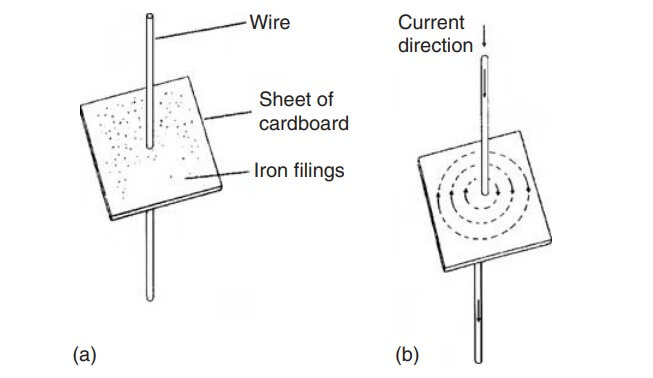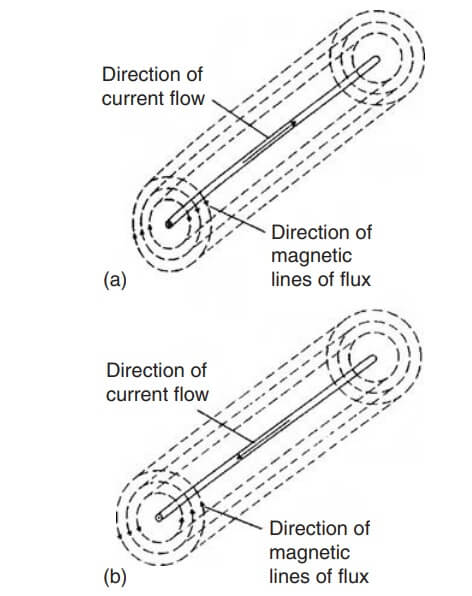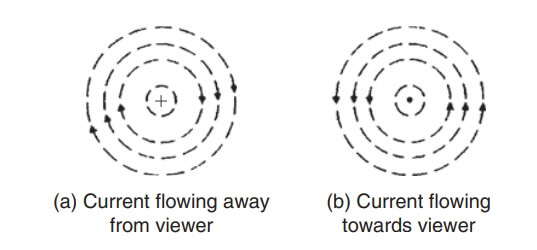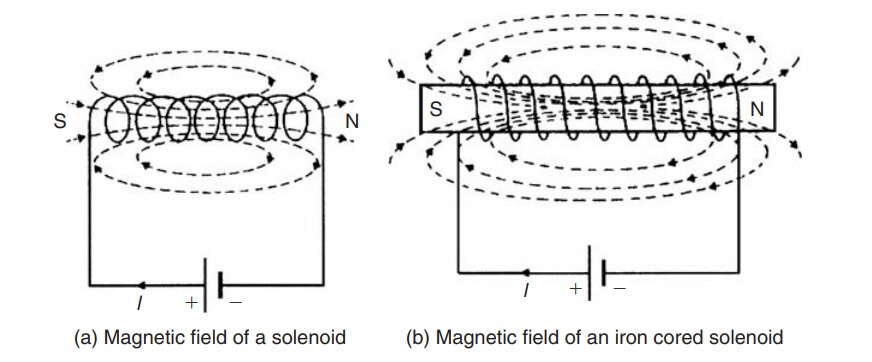Magnetic fields can be set up not only by permanent magnets, but also by electric currents.
Let a piece of wire be arranged to pass vertically through a horizontal sheet of cardboard on which is placed some iron filings, as shown in Fig (a). If a current is now passed through the wire, then the iron filings will form a definite circular field pattern with the wire at the centre, when the cardboard is gently tapped. By placing a compass in different positions the lines of flux are seen to have a definite direction as shown in Fig (b).
If the current direction is reversed, the direction of the lines of flux is also reversed. The effect on both the iron filings and the compass needle disappears when the current is switched off.

The magnetic field is thus produced by the electric current. The magnetic flux produced has the same properties as the flux produced by a permanent magnet. If the current is increased the strength of the field increases and, as for the permanent magnet, the field strength decreases as we move away from the current-carrying conductor.
In Fig, the effect of only a small part of the magnetic field is shown. If the whole length of the conductor is similarly investigated it is found that the magnetic field round a straight conductor is in the form of concentric cylinders as shown in Fig, the field direction depending on the direction of the current flow.



When dealing with magnetic fields formed by electric current it is usual to portray the effect as shown in Fig The convention adopted is:
- Current flowing away from the viewer, i.e. into the paper, is indicated by ⊕. This may be thought of as the feathered end of the shaft of an arrow. See Fig (a).
- Current flowing towards the viewer, i.e. out of the paper. This may be thought of as the point of an arrow. See Fig (b).
The direction of the magnetic lines of flux is best remembered by the screw rule which states that:
If a normal right-hand thread screw is screwed along the conductor in the direction of the current, the direction of rotation of the screw is in the direction of the magnetic field.
For example, with current flowing away from the viewer (Fig (a)) a right-hand thread screw driven into the paper has to be rotated clockwise. Hence the direction of the magnetic field is clockwise.
A magnetic field set up by a long coil, or solenoid, is shown in Fig (a) and is seen to be similar to that of a bar magnet. If the solenoid is wound on an iron bar, as shown in Fig (b), an even stronger magnetic field is produced, the iron becoming magnetised and behaving like a permanent magnet. The direction of the magnetic field produced by the current I in the solenoid may be found by either of two methods, i.e. the screw rule or the grip rule.
- The screw rule states that if a normal right-hand thread screw is placed along the axis of the solenoid and is screwed in the direction of the current it moves in the direction of the magnetic field inside the solenoid. The direction of the magnetic field inside the solenoid is from south to north. Thus in Figs (a) and (b) the north pole is to the right.
- The grip rule states that if the coil is gripped with the right hand, with the fingers pointing in the direction of the current, then the thumb, outstretched parallel to the axis of the solenoid, points in the direction of the magnetic field inside the solenoid.
| Read More Topics |
| Capacitors connected in parallel and series |
| Alternative and renewable energy sources |
| EMF and internal resistance of a cell |
| Resistor colour coding and ohmic values |





